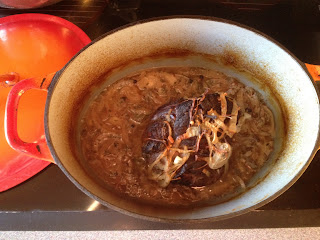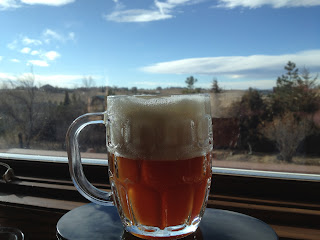I have wanted to attend the Big Beers, Belgians, and Barley Wines Festival in Vail, Colorado, since I first heard about a few years ago when I returned to Southeastern Wyoming for grad school. I finally made it down for the commercial tasting session of the 12th Annual event on January 7th. The festival lasts for three days and is filled with seminars and a homebrew competition (missed the submission date--again), but on the final afternoon there is a commercial tasting session that resembles other beer festivals with the exception that all beers are of a Belgian style and/or over 7% ABV. With very few exceptions, the beers were all big.
My friend Eric and I drove down on Saturday morning to Vail, a trip of about 3 hours. The snow started to fall as we climbed in elevation up and over the Continental Divide at 11,158 ft at the Eisenhower Tunnel (highest point on the interstate highway system). By the time we dropped into Vail, a few inches of snow had fallen and would continue to fall through the night, totalling apx. 10''. It was a beautiful Norman Rockwell snow that fluttered straight down and blanketed everything, not like the sideways snow of Wyoming's high plains I am used to.
 |
| Fellow Wyoming Beer Lovers |
Our room wasn't ready, so we strolled around the village and got a little lunch at a French cafe and then caught a bus to the hotel holding the festival and jumped in line outside with the rest of the freezing and thirsty festival goers. After just a minute in line, a group of people from Wyoming, including my buddy Matt, who is also a home brewer, fell into line immediately behind us. Matt wasn't wearing a coat but he did come dressed with a pretzel necklace to keep him warm in line. It was nice to have some WY pals to enjoy the festival with, especially since our friend George had bailed on us to attend the Broncos/Steelers playoff game instead.
 |
| Birthday Card for George who Bailed on the Trip. |
Writing about a beer festival is something that I find incredibly difficult to do and while there were many fewer breweries at the BBBBW, the high ABV of every beer made up for it. How many Imperials, Old Ales, Tripels, Quads, and Barley Wines can you drink in one afternoon? It was nice to find Saison's and Farmhouse beers mixed in as well as a few Biere de Garde's, although they were hit and miss as some were really sticky. Not only does the drinking make recall and writing about a festival difficult, but when there are so many beers at a festival it is extremely hard to keep track of everything. There were over 100 breweries represented and most bring 2-5 beers each, so I will not be able to do a proper review, but I will point out some my personal standouts.
One of the best reasons to attend beer festivals is to try beer from breweries one hasn't had, and I was quite impressed with
Stronghold, a newly online brewery in Central City, CO that was basically using the festival for a coming out party as they do not yet have a tap room or package their product. According to the guys at the booth they have just recently put there beer on two or three tap handles in the area. The Delilah, a Mexican Chocolate and chili pepper stout was really delicious, as was the Bottomry Braggot, made with Orange Blossom honey. The Bottomry was by far the best braggot I tasted at the festival.
Funkwerks and
Crooked Stave, a couple of local favorites, really stood out from the crowd (I hope I'm not being biased based on my preheld love of these breweries). Funkwerks brought their flagship Saison, which was like a drink of water in the desert that I went back for a few times to refresh myself after all of the heavy and sweet beers. Funkwerks brought a new Imperial Saison, Tropic King, a Bourbon Dark Saison, and the annual Cherry Saison. This brewery just does not make bad beer and if you haven't been to the tasting room in Fort Collins, it is time for a special trip. Currently, Funkwerks shares brewing space with Crooked Stave, although it sounds like CS will be relocating to their own brewery which sadly will be located in Denver. Crooked Stave had two of the better beers I had all day, a Chardonnay Barrel aged Belgian with Brett that was that hard to hit quality of extremely drinkable and extremely complex. Possibly my favorite beer of the day was Crooked Stave's Wild Wild Bret Green, basically a pale ale fermented entirely with Brettanomyces. Wild Wild uses more than 3 lbs. of Galaxy hops per barrel and is a true achievement in brewing.
 |
| With Nathan from Altitude and Doug Odell |
Wyoming was only represented by one brewery,
Altitude, from Laramie. The brewer and I talked Pokes basketball and got our pictures taken with Doug Odell, founder of Odell's brewery. That was the other fun thing about this festival and while there aren't as many "famous" people from the brewing world as there are at the GABF, I mean, Sam Calagione poured me a beer, which is a fun thing. With the exception of the distributors, there were few booths that were staffed by people not associated with the brewery. One of my biggest complaints with most beer festivals is the lack of brewery representation at them. Part of what makes festivals fun is the opportunity to interact with the brewers and many summer festivals are staffed almost entirely by volunteers. Another complaint I have with festivals is when breweries go to a festival in their own region and take only their flagship beer or a couple that are in every liquor store in the area. It is an opportunity to give their customers something special and with so many beers to try if there isn't anything new or special I won't stop at that booth.
The distributor's booth's were packed with an amazing selection of Belgian imports but most attention seemed focused on the domestic craft brews.While it was nice to see the bigger brewers from other regions such as Allagash, Bell's, The Bruery, Boulevard, Dogfish Head (bringing 8 beers), Firestone Walker, Lost Abbey, Ommegang, Stone etc., it was great to find out what the numerous Colorado breweries were up to and just as some brewers such as New Belgium and Oskar Blues are outgrowing the region there is a seemingly endless stream of new breweries like Dry Dock and Stronghold popping up in the Centennial State. But it is safe to say that the format of Big Beers, Belgians, and Barleywines, was tailor made for one Colorado brewery in particular.
Avery showed up with more than five beers over 9%, two of which were 16% ABV. The standout for me was the Coffeestopheles Imperial Stout, which rang in at 16.4% and was extremely complex, boozy, and delicious.
 |
| Eric and I realizing too late we hadn't taken any pictures of Vail |
In the end, it is easily one of the best beer festivals I have been to, and it is a nice excuse to spend a night in Vail and go to a festival during a period of the year when there are few to none. It would be nice to take a bit more time and enjoy some of the other events but I can really only justify paying for the tasting ticket and one night in a Vail hotel. Tickets to the tasting were $50, and the hotels have specials if you let them know you are with the festival. Ours was just over $200, which is fairly cheap (by Vail standards). After the festival we went and had wings and a nice steak before going out for drinks, however, the drink was scotch--I had my fill of beer for the day.
On Sunday the weather had cleared but my head hadn't quite. There were accidents along I-70, slowing traffic to a crawl. Eric was a trooper and drove us all the way back to Fort Collins just in time to catch kick off of the Broncos playoff game at his house.

 I wasn't able to use the Belgian Ale strain I had reserved for the cider due to using it when another yeast was bunk earlier in the week when brewing a beer. I had to go with wine yeast I had in the fridge, Lalvin K1-V1116 (Montpelier). My original plan of using a spicy ale yeast was out, so I figured I would add my own spices. I ground up a little Indian Coriander and dumped out the last of my dried chamomile from last years garden. I decided not to add additional sugar and just ferment what is in the juice and also not add bottling sugar but instead bottle before fermentation was quite complete and add a small amount of good quality Minnesota maple syrup at that time--hopefully resulting in 3 gallons of a nice pellant or fizzy cider and not bottle bombs or still apple cider.
I wasn't able to use the Belgian Ale strain I had reserved for the cider due to using it when another yeast was bunk earlier in the week when brewing a beer. I had to go with wine yeast I had in the fridge, Lalvin K1-V1116 (Montpelier). My original plan of using a spicy ale yeast was out, so I figured I would add my own spices. I ground up a little Indian Coriander and dumped out the last of my dried chamomile from last years garden. I decided not to add additional sugar and just ferment what is in the juice and also not add bottling sugar but instead bottle before fermentation was quite complete and add a small amount of good quality Minnesota maple syrup at that time--hopefully resulting in 3 gallons of a nice pellant or fizzy cider and not bottle bombs or still apple cider.






























